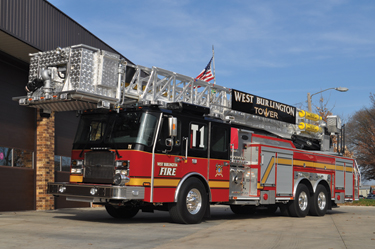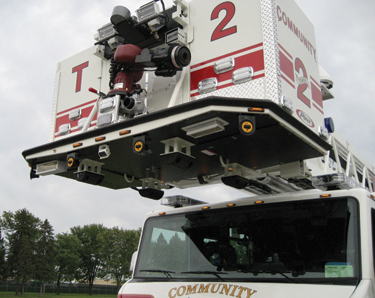Alan M. Petrillo
Firefighters are asking for more and varied equipment to be placed in, on, and around aerial platforms, and apparatus manufacturers are giving it to them, allowing platforms to be used in more and more versatile ways.
Tool Choices
Joe Hedges, product manager of aerials and chassis for E-ONE, says that “a platform’s calling in life is as an elevated working station, so you want the tools out there that will be needed to do the job.” He notes that although there is a core of standardized equipment often found on platforms, each fire department has its own requirements for additional tools and equipment that might be placed there.
“Commonly you’ll find either a single or dual monitor on a platform, breathing air, pike poles and axes, and 2½- and 1½-inch hose connections,” Hedges says. “There’s usually a Stokes receiver in the basket, and we designed our 100-foot aerial platform so the Stokes could be carried in three positions-left, right, or at the rear of the bucket.” E-ONE routinely installs ground ladder attachments, lifting arms, and winch mountings on platforms, he notes.
Pete Hohrechak, aerial product manager for KME, says common accessories that KME puts on platforms include Stokes basket mounts; rappelling eyes and equipment lowering points; and parapet ladder mounts that allow a standard roof ladder to be affixed to the platform, allowing egress below a parapet.
 |
|
(1) E-ONE’s 100-foot aerial platform devices, like this one for the West
|
“Most fire departments want hand tool points for axes, pike poles, and saw mounts,” Hohrechak notes, “and you can find them mounted both inside and on the outside of a platform. Some departments have electric cord reels installed in their buckets, and most of them have preconnects built in.”
The most unusual piece of equipment that KME has put in a platform, Hohrechak believes, was a Hurst tool. “We preplumbed the hydraulics in the platform for a combination tool,” he says, “which was stored inside the bucket in a special bracket.”
Tim Smits, senior national sales manager for Pierce Manufacturing Inc., says fire departments are looking to place the greatest amount of equipment closest to where they will use it, and that includes aerial platforms. “Mounting equipment in a platform means a firefighter doesn’t have to carry it up and down a ladder,” Smits says. “They want the equipment near the tip of the aerial or in the basket.”
Smits notes that he’s seen equipment such as rappelling arms, winches, ladder brackets, axe mountings, halligan tools, storage boxes for saws, and hose boxes on platforms. “Pierce offers the Lyfe bracket for platforms, which is a three-in-one bracket that pins to the front of the bucket,” he says. “It functions as a rappelling eye, a roof ladder bracket to lock in and go over a parapet, and also as a Stokes basket bracket that doesn’t take up room inside the platform.” Pierce also has installed digital video and thermal imaging cameras on platforms, as well as Opticom traffic controls.
Rosenbauer has had requests “for almost everything to be put on platforms, from hose roll boxes to hand tool mountings, high-rise pack mounts, rope bags, air tools, waterway adapters, and electrical connections for saws. We even did a charging mount for an electric Hurst tool in a bucket,” according to Mike Harstad, aerial products manager at Rosenbauer.
Paul Christiansen, marketing director and aerial product manager for Ferrara Fire Apparatus, says Ferrara has been offering a parapet ladder bracket for about three years, adding that it’s an option that’s chosen on the majority of platforms Ferrara builds.
Chuck Glagola, aerial product specialist for Smeal Fire Apparatus, notes the days of an empty platform basket are long gone. “Fire departments are trying to get as much equipment as possible into their platforms,” he says. “They want a K-12 or other ventilation saw up there, hand irons, preconnected protection lines, and parapet ladder attachments, which we are putting on two out of three of our aerials.”
Aerial platforms are becoming tool and equipment carriers, Glagola adds. “Their wide variety of uses has resulted in increased requests for storage of equipment such as ground ladders, pike poles, hooligan tools, thermal imaging devices, rescue tools, and other things,” he says.
 |
|
(2) KME offers the Task Force Tips (TFT) Valve Under Monitor (VUM)
|
Smeal uses a Load Minder system for its aerials, where live time readings are taken of the downward force on the aerial’s lift cylinders. “The system takes into consideration the manpower and equipment in the basket,” Glagola points out, “as well as any ice buildup, reactionary force from the nozzle, wind resistance, and the weight of the water in the pipes.”
Water Flow
Tony Mastrobattista, aerial sales manager of the north region for Spartan ERV, says that the primary function of an aerial platform is rescue, followed by ventilation, extinguishment, and as an observation platform for size-up. “But, the most important piece of equipment on a platform is the water delivery system,” Mastrobattista says. “More fire departments are putting a second monitor, or even a third, on their platforms. The ability to discharge two master streams is very handy on a multiple fire incident.”
Mastrobattista notes one stream could be directed at the main fire target while a second is available to protect exposures or provide cooling to adjacent structures. “The second monitor also can be used on a fog pattern to protect firefighters in the platform from radiant heat,” he observes.
 |
|
(3) Firefighters from the Lexington (KY) Fire Department train using
|
Electric and wirelessly controlled monitors are enhancements that allow for a big safety advantage, Mastrobattista says, where they can be operated from the turntable operator’s station or from a portable handheld keypad from up to several hundred feet away.
Hohrechak says that all KME platforms are designed to handle either single or dual monitors. “The majority installed on our platforms are dual monitors,” he adds, “and those are evenly split between manually and electrically controlled monitors. We like to use the Task Force Tips (TFT) Valve Under Monitor (VUM) that has a full flow waterway to the monitor, which can be shut down at the bucket to allow 2½- and 1½-inch discharges to be opened for an elevated standpipe operation.”
At HME, Ahrens-Fox spokesman Marc Dettman says the company’s Scorpion 104-foot platform with tandem front steer axle and rear dual drive axle is the first fire apparatus in the industry to incorporate a touch screen for simplified and more responsive valve control. The pump valves of the Scorpion’s big-bodied split shaft pump that controls the platform’s waterway, he notes, are all networked using nonproprietary SAE J1939 controls. Besides the new control technology, HME moved the pump control panel location to the opposite side of the front outrigger to protect operators and crews from being injured or knocked off the platform by charged lines.
 |
|
(4) This Rosenbauer Cobra platform shows dual side door entries at
|
Lighting Equipment
Quartz lighting on platforms is becoming more popular, Smits points out, from 110-volt lighting fed off of a generator to 12-volt LEDs, which he says are “super bright and draw hardly any voltage.”
KME offers telescoping quartz lights at the front and back of its platforms and recessed lighting on the front, sides, and under the bucket. “We’re seeing a lot of departments choosing the 120-volt LED lights for the platform because of their high lumen output,” Hohrechak observes.
Mastrobattista agrees that LED lighting is becoming popular on platforms, especially because of its low power consumption. In addition, Spartan ERV uses LED lighting to illuminate the ladder itself, he says, and the LEDs are available in white, yellow, green, blue, and red. “Blue has been shown to put out the best amount of light in foggy and smoky conditions,” Mastrobattista notes.
Harstad also agrees that fire departments are focusing more on placing lighting on platforms. “LED 12-volt scene lighting is getting a lot better, and you can get lots of light from 110-volt 500-watt, 1,000-watt, and 1,500-watt heads,” he points out. “I’ve never been on a fire scene where someone said, ‘I wish we had less light.’ “
Harstad adds that some departments want the platform to serve several purposes and have installed up to 3,000 watts of lights so they can put it up in the air and use it as a light tower.
 |
|
(5) Pierce Manufacturing offers distance measurement sensors on its
|
View from Above
Hedges points out that E-ONE is currently building an aerial platform that incorporates Intec Video Systems’ Video Sentinel system of a digital camera on one side of the front of the platform and an infrared camera on the other.
Smits also notes that one Pierce aerial platform customer-the Community (TX) Volunteer Fire Department-put a backup camera under the platform facing forward so it could view a fire scene on the truck’s multiplexing system. “They saved the cost of a standard digital video camera by using a backup camera,” Smits notes.
Christiansen says he’s seen more and more departments requesting digital video cameras on the front of their platforms. “They want to be able to have a good, clear view of the scene from the turntable of the truck,” he says.
 |
|
(6) HME’s 104-foot tandem front steer platform incorporates a touch
|
Safety First
Loading up a platform with equipment can mean trouble with weight if too much is included in it, Hedges says. “An aerial is designed to handle a certain amount of design load and a certain equipment load,” he says. “E-ONE has a 1,000-pound personnel allowance, or four firefighters, and 305 pounds of equipment, so 1,305 pounds is the load the machine can carry and maintain its safety factors.” He adds that the equipment load includes monitors, lights, tools, hoses, and saws.
Although E-ONE meets customer requirements for tools and storage on platforms, Hedges cautions that it “tries not to get too outrageous because there are limitations on the working end of the aerial. We try to educate our customers so there’s limited risk and hazard.”
Harstad echoes the sentiment that a manufacturer has to advise a customer carefully about the amount of equipment that can be loaded into or onto a platform. “We allow for 1,000 pounds of live load and 100 pounds of equipment,” he says. “The square footage and load capacity are at a premium on platforms.”
“We’ve equipped platforms with distance measurement sensors that sense how close the bucket is to a structure,” Smits says. “At 10 feet, an indicator turns red and gives an alarm pulse; at five feet, the alarm is steady; and the system can be set to automatically stop. However, most customers set the system so the operator is in control because he might determine a need to get closer to the structure to do a rescue.”
ALAN M. PETRILLO is a Tucson, Arizona-based freelance writer and is a member of the Fire Apparatus & Emergency Equipment editorial advisory board. He served 22 years with the Verdoy (NY) Fire Department, including in the position of chief.

